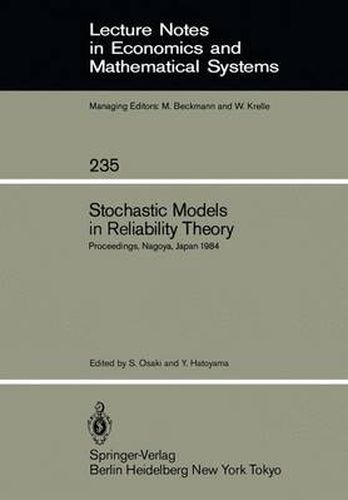Readings Newsletter
Become a Readings Member to make your shopping experience even easier.
Sign in or sign up for free!
You’re not far away from qualifying for FREE standard shipping within Australia
You’ve qualified for FREE standard shipping within Australia
The cart is loading…






This title is printed to order. This book may have been self-published. If so, we cannot guarantee the quality of the content. In the main most books will have gone through the editing process however some may not. We therefore suggest that you be aware of this before ordering this book. If in doubt check either the author or publisher’s details as we are unable to accept any returns unless they are faulty. Please contact us if you have any questions.
In Japan there are many research workers who are especially inter- ested in stochastic models in reliability theory. On the above back- ground, it was a nice occasion for the Editors to organize the Reliabil- ity Symposium with emphasis on Stochastic Models in Reliability Theory. The Reliability Symposium was held in Nagoya, Japan, April 23-24, 1984. In the Symposium there were 14 contributions of the recent research works on stochastic models in reliability theory in Japan. We briefly sketch all the contributions by the following classifications just for conveni- ence. The first three papers discuss coherent structure theory: Miyakawa considers stochastic coherent systems where the system’s state can not be completely determined by the states of its components. He shows that such models will be used in identifying the failure mechanism based on failure pattern data. Ohi and Nishida propose multistate systems in which all the state spaces are not necessarily the same, but somewhat strong coherency is assumed. Nakashima and Yamato discuss multivalued- output systems and su~gest the type of redundancy effective for improv- ing- fail-safe characteristics of such systems. The next two papers are concerned with maintenance and replacement problems: Nakagawa summarizes seven replacement models with discrete variables. He shows that each optimal number is given by a unique solu- tion to equation. Kaio and Osaki consider optimum inspection policies for a system whose failure can be detected effectively. They discuss three inspection models and give their optimum inspection policies.
$9.00 standard shipping within Australia
FREE standard shipping within Australia for orders over $100.00
Express & International shipping calculated at checkout
This title is printed to order. This book may have been self-published. If so, we cannot guarantee the quality of the content. In the main most books will have gone through the editing process however some may not. We therefore suggest that you be aware of this before ordering this book. If in doubt check either the author or publisher’s details as we are unable to accept any returns unless they are faulty. Please contact us if you have any questions.
In Japan there are many research workers who are especially inter- ested in stochastic models in reliability theory. On the above back- ground, it was a nice occasion for the Editors to organize the Reliabil- ity Symposium with emphasis on Stochastic Models in Reliability Theory. The Reliability Symposium was held in Nagoya, Japan, April 23-24, 1984. In the Symposium there were 14 contributions of the recent research works on stochastic models in reliability theory in Japan. We briefly sketch all the contributions by the following classifications just for conveni- ence. The first three papers discuss coherent structure theory: Miyakawa considers stochastic coherent systems where the system’s state can not be completely determined by the states of its components. He shows that such models will be used in identifying the failure mechanism based on failure pattern data. Ohi and Nishida propose multistate systems in which all the state spaces are not necessarily the same, but somewhat strong coherency is assumed. Nakashima and Yamato discuss multivalued- output systems and su~gest the type of redundancy effective for improv- ing- fail-safe characteristics of such systems. The next two papers are concerned with maintenance and replacement problems: Nakagawa summarizes seven replacement models with discrete variables. He shows that each optimal number is given by a unique solu- tion to equation. Kaio and Osaki consider optimum inspection policies for a system whose failure can be detected effectively. They discuss three inspection models and give their optimum inspection policies.